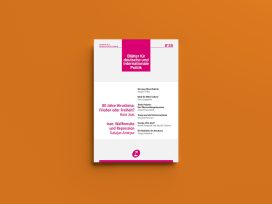From 2007 to 2013, 347 billion euros are set to go to projects financed through the European Union Structural Fund and the Cohesion Fund, more than a third of its overall budget for the seven-year period. Over half of this amount – 177 billion euros – will go to the central and eastern European (CEE) member states. The EU funds are the main instrument for delivering the cohesion policy of the EU, which aims to close the gap between the richer, old member states and the poorer newcomers from behind the former Iron Curtain.
Given the significant amount of money involved, it is important that the development being funded contributes to achieving the climate and environmental protection objectives of the EU. The EU will have to act quickly if, as recently endorsed, it is to cut its greenhouse gas emissions by 20 to 30 per cent by 2020, and by 60-80 per cent by 2050. In the 1990s, greenhouse gas emissions in CEE countries declined substantially as a result of economic restructuring. Since 2002, however, they have been on the rise again, and are projected to increase by 11 per cent between 2004 and 2010.
While almost all CEE countries are likely to meet their Kyoto goals, such developments could jeopardize efforts for necessarily bigger emission cuts after 2012. Indeed, the strongest resistance to EU emissions reduction targets for 2020 and related energy policies is coming from some CEE member states. EU funds must be used to help these countries move towards a sustainable and climate-friendly pattern of development.
Energy policy: Reversing the legacy of the planned economies
Energy efficiency and renewable energy are at the top of the European political agenda today. The European Union has already committed itself to increasing the share of renewable energy in primary energy consumption from 6 per cent to 12 per cent by 2010 and to 20 per cent by 2020. It has also pledged to take action to reduce energy consumption by 20 per cent by 2020, which it claims will save 100 billion euros a year and create one million jobs in Europe.
The EU has also adopted a number of specific directives and targets in areas such as the energy performance of buildings, efficiency of appliances, energy end-use efficiency, biomass energy, and cogeneration. As a result of these developments, energy efficiency and renewable energy have received increased prominence within the EU cohesion policy, at least at the level of political rhetoric.
As a legacy of the centrally planned economies, the economies of the CEE countries are very energy intensive and wasteful. It requires double the energy to produce one unit of GDP in the new member-states uses than it does in the old member-states. The potential for cost-effective energy savings in the region is therefore huge. High-energy intensity increases production costs and undermines the competitiveness of the CEE countries within the single market. EU funds could help secure massive energy savings across the economy and reduce energy bills not only for businesses, but also for households, schools, hospitals, and other public facilities.
Areas into which EU funds should be invested include energy-efficient refurbishment of buildings and modernization of district heating installations. The high-rise residential buildings in CEE towns and cities are severely wasteful in heat. Approximately 40 per cent of households in central eastern European countries are connected to district heating, in comparison to 10 per cent in the old member states. Old coal or oil boilers can be converted to modern, efficient gas or biomass boilers. There is also a large, untapped potential for the integration of solar thermal and geothermal energy into district heating systems. Many district heating installations can be redesigned for the combined generation of heat and electricity.
EU funds could also be used to unlock the large but unused renewable energy potential of the CEE countries. The costs of wind, solar, biomass and geothermal energy have been steadily falling rapidly in recent years, mainly due to the learning effect and economies of scale. In the new member states, the share of renewables in electricity consumption is only 5.7 per cent, as opposed to 14.7 per cent in the old member states.
CEE countries are in danger of missing the boat of technological innovation unless they utilize the momentum created by the EU financial support. All have adopted national targets for increasing their share of renewable energy and almost all have been using EU structural funding for the promotion of renewables to some extent. However, support for renewables can be greatly enhanced. Investment in energy efficiency and renewables would not only reap environmental benefits, but would also contribute to more balanced and sustainable regional development in the new member-states – the prime goal of EU funds.
According to the data, 4.2 billion euros in total – only 2.4 per cent of total EU funding for central eastern European countries – is to be invested into energy efficiency and renewable energy from 2007 to 2013. Funding stands to be shared approximately 50-50 between both sectors. A comparative view reveals major differences between the funding plans of the individual countries. Lithuania stands out by allocating 5.4 per cent of all its EU funds; the Czech Republic follows with 4.5 per cent and Slovenia with 3.8 per cent. Support for energy efficiency and renewables is most neglected in Poland, Slovakia and Hungary, which have allocated to them only around 1.5 per cent of their total EU funding. It is worth noting in this context that Poland and Hungary are the two member-states that have most resisted adopting binding EU targets for reducing greenhouse gas emissions by 2020.
In order to achieve low-carbon development, it is equally important to ensure that energy efficiency and renewable energy are integrated as much as possible into all other measures and activities to be financed by EU funds. For example, any EU investment in buildings and housing should systematically integrate energy-saving measures and renewable energy technologies. The measures for the modernization of Slovakian universities, which explicitly include significant improvements in the energy efficiency of buildings, are an interesting example. Overall, however, there are few signs that energy efficiency and renewable energy will consistently be considered a priority in all EU funded investments.
Transport: the key to a low-emissions future
Increasing car and truck traffic use in CEE countries means that transport is the fastest growing source of greenhouse gas emissions in the region. While overall greenhouse gas emissions fell from 1995 to 2004, transport CO2 emissions soared by 40 per cent. Overall emissions are now rising again as a result of the increase in car use, thus threatening any future emissions reduction goals.
Transport emissions can be cut through a combination of increased fuel efficiency and alternative fuels, road pricing and modernization of public transport, better urban planning and “soft measures” for inducing behavioural changes. In the old EU member-states, trains produce three times fewer CO2 emissions per passenger-kilometre than passenger cars. For freight transport, trains produce over five times fewer emissions per tonne-kilometre than trucks.
Transport should increasingly be shifted to low-emission modes (e.g. from road to rail), and the overall transport intensity of the economy – volume of transport per unit of GDP – should be reduced. Where EU funds can help is mainly by modernizing public transport and railways in order to provide an alternative to car and truck transport, by supporting bicycle infrastructure, traffic management and by shifting freight from road to rail. What EU funds should not do is aggravate negative trends by prioritizing high-emission road and air transport.
The Community Strategic Guidelines for Cohesion 2007-2013 include the promotion of “environmentally sustainable transport networks, particularly in urban areas” among funding priorities. The communication “Cohesion Policy and cities: the urban contribution to growth and jobs in the regions” stresses the need to “improve the affordability, efficiency and effectiveness of public transport, as well as to link different transport modes” and to “promote the use of cycling, walking and other ‘soft’ forms of transport” as part of an integrated transport strategy for urban areas. The question is whether these objectives are going to be backed up by the EU funds in central eastern Europe, and by how much.
Apart from lower energy consumption and greenhouse gas emissions, public transport has numerous other advantages over car use. Modernizing public transport is essential for avoiding congestion, accidents, noise, pollution, and land take resulting from individual car transport. Public transport is safer: the number of people seriously injured and killed per passenger-kilometres is 10-20 times lower for public transport than for cars. In cities, public transport uses valuable urban space much more economically than cars: transport from home to work by car, including parking, requires 20 times more space-time than by bus or tram. Cars lead to congestions that bring billions of euros worth of damage to Europe’s economy annually, and are responsible for the fact that air quality and noise standards are not met in many cities. The development of public transport, the limiting of car-use and the creation of pedestrian zones has been shown to reinvigorate cities and to increase sales in shops. Large categories of people who do not have access to a car – usually people with lower-incomes, older people, women – depend entirely on public transport.
In the CEE countries, there has been a massive exodus of freight and passengers from rail and public transport to road over the last 15 years. Car ownership has exploded and public transport use has decreased considerably. A major explanation for this development lies in the under-financing of public transport and railways and the prioritization of investment in road infrastructure. In other words, the switch from rail and public transport to cars and trucks has been subsidized using public funds.
Although the share of passengers transported by public transport in CEE countries has declined, it is still considerably higher than in the old EU member-states. There are fifty tram systems in the region, the highest concentration in Europe. Most CEE cities have plans to modernize public transport networks and rolling stock, but have been limited by the lack of funds. Like public passenger transport, the share of freight transported by rail is still significantly higher in eastern central Europe. In this respect, the transport sector in the region is still closer to the ideal of a balanced modal split. In 2001, the EU White Paper on Transport demanded: “Every effort must therefore be made to convince the [eastern central European countries] of the need to maintain the railways’ share of the freight market at a high level, with a target of around 35 per cent for 2010.”
Altogether, 55 billion euros of EU funding is allocated to transport in the Operational Programmes of the CEE countries for 2007-2013. Less than one-third of the transport funding (15 billion euros) is to be invested in railway infrastructure, and only one-tenth (5.7 billion euros) in urban public transport. The biggest slice of the pie – 55 per cent – goes to road construction (including motorways, national, regional and local roads). Approximately one billion euros is to be invested in ports, another one billion euros in air travel, while inland waterways are to receive half a billion euros. Multimodal transport and “intelligent transport” is to receive only 1.5 billion euros; cycle tracks will receive approximately 0.4 billion euros.
While railways have received varying allocations in all countries, allocations for clean urban transport are extremely inconsistent. Bulgaria, Lithuania, Romania, Slovakia and Slovenia score the lowest on public transport, allocating very little EU funding in this sector. Hungary and Estonia will allocate the most EU funding to public transport. Estonia aims to preserve the 35 per cent share of public transport in total passenger kilometres, to increase the number of electric rail passengers by 50 per cent, and tram and trolleybus passengers by 35 per cent by 2013. Unfortunately, such objectives and indicators are exceptional among the CEE countries.
Even where some support for public transport is planned, it is rarely comprehensive. In the Czech Republic, Bulgaria and Hungary, most of the public transport money will go to one single project – the extension of the underground systems in the capital cities. In Poland, prioritizing urban public transport does not include funding for new environmentally friendly buses, despite the fact that 50 per cent of Polish urban buses are over 10 years old, and despite the fact that bus transport in Poland is very high compared to other modes of public transport.
Instead of using EU funds to systematically improve public transport, governments are focusing on road building. Taken together, more than a half of all EU funds for transport in CEE countries is to be invested in roads. Roads and motorways are to receive especially high shares of the funding in Poland and Slovakia (who plan to spend most on transport in general). A gross imbalance thus exists in favour of one of the most climate-damaging modes of transport and the business-as-usual trend in transport financing in the CEE region continues.
A number of studies have undermined the widespread conviction that motorways are essential to regional development and employment creation. Experience around the world also shows that it is not possible in the long term to solve congestion problems by building ever more roads. As the European Federation for Transport and Environment puts it: “Building road infrastructure inflates transport demand just as printing money creates inflation.” The social costs of transport, such as accidents, damage to health through air pollution and noise, and climate change impacts, have been estimated at 7.3 per cent of the EU’s GDP. These costs are almost exclusively caused by road transport (84 per cent) and aviation (14 per cent).
Aviation, which has the highest climate impact of all transport modes, is to receive one billion euros of EU subsidies in the CEE countries. Seven out of ten CEE countries plan to use EU funds for aviation – Poland, Romania, Lithuania, Latvia, Estonia, Czech Republic and Slovenia. According to the European Environment Agency, air transport in the EU is already receiving a gigantic subsidy of 27 to 35 billion euros annually as a result of being exempted from fuel-tax and VAT. Given this, any extra public funding for aviation from EU funds is not justifiable.
Time to deliver
EU funding for the 2007-2013 period is a unique opportunity to assist the CEE countries in moving on a climate-friendly path of development. The CEE countries can do this if they systematically direct funds towards energy efficiency, renewable energy and sustainable mobility investments. However there is little evidence of financial commitment towards such projects. Only 4.2 billion euros in total – only 2.4 per cent of all EU funds – are allocated to energy efficiency and renewable energy. There are few, if any efforts to systematically integrate energy-saving measures and renewable technologies into all suitable projects.
In the transport sector, the majority of funds – 30 billion euros – will be spent on roads and motorways that generate more car and truck traffic and thus more emissions. Only 5.7 billion euros has been allocated to clean urban public transport, whose annual CO2 emissions per passenger-kilometre are three times less than cars. EU funding policy does not match official statements on commitments to energy efficiency, renewables and clean urban transport.
Given the large volumes of funding that are to become available to the CEE countries, the development of their economies in the upcoming seven-year period will be fundamentally influenced by choices made in the EU funding policy. Investments already allocated by the European Commission are likely to place the CEE countries on a course of unsustainable and energy-intensive development, meaning that CEE countries will have to make much costlier emission cuts later on.
EU funds should be used to help beneficiary states move towards a low-carbon development by earmarking high minimum funding shares to key low-carbon investments such as energy efficiency, renewables and public transport. At least 75 per cent of all transport funding should be allocated to environmentally friendly transport projects. Simultaneously, the financing of climate-damaging investments should be reconsidered. Financed projects should comply with ambitious energy efficiency criteria and energy-saving measures, while renewable energy technologies should be systematically integrated into all projects where feasible.






